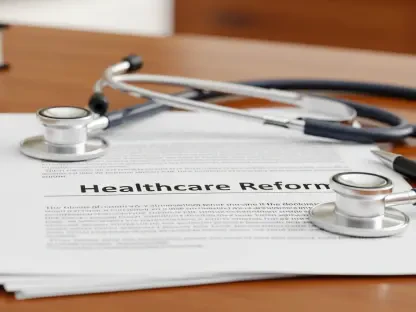The Medical Debt Crisis in OklahomScope and Significance
Imagine a family forced to choose between seeking life-saving medical treatment and facing a mountain of debt that could shatter their financial stability. This harsh reality grips over a third of adults across the United States, and Oklahoma is no exception, with medical debt emerging as a leading cause of bankruptcy in the state. The burden of these unpaid bills weighs heavily on households, often leading to severe consequences such as delayed care, mounting stress, and eroded savings, painting a grim picture of healthcare affordability.
The significance of this crisis extends beyond mere numbers, as fear of costs deters countless Oklahomans from accessing necessary medical services, exacerbating health issues and creating a vicious cycle of untreated conditions and escalating expenses. This hesitation impacts not just individual well-being but also community health outcomes, placing strain on local systems and resources. Addressing this issue has become a priority for a range of stakeholders, including state lawmakers, the Oklahoma Hospital Association, and agencies like the Oklahoma State Department of Health, all working to mitigate the fallout.
Nationally, medical debt remains a pervasive challenge, with federal policies often shaping the framework within which states must operate. Oklahoma’s response, while localized, is influenced by broader discussions on healthcare reform and federal funding mechanisms like Medicaid. These external factors underscore the complexity of crafting effective solutions at the state level, highlighting the urgent need for coordinated efforts to protect vulnerable populations from the crushing weight of medical expenses.
Legislative Efforts to Combat Medical Debt
Key Bills and Transparency Initiatives
In a rare display of bipartisan unity, Oklahoma lawmakers have rallied behind significant legislative measures to address medical debt, with a strong emphasis on transparency in healthcare pricing. Senate Bill 889 and House Bill 4148, both enacted in recent years, stand as cornerstones of this effort, mandating hospitals to disclose costs for common services and linking debt collection practices to compliance with these transparency rules. These laws aim to arm patients with critical information to make informed financial decisions about their care.
Additional protective measures are also gaining traction, with proposals like Senate Bill 519 and House Bill 1709 focusing on shielding individuals from the long-term repercussions of medical debt by preventing such obligations from tarnishing credit scores. These bills represent a proactive approach to safeguarding financial health alongside physical well-being. Transparency, as a central theme, not only empowers patients but also holds the potential to drive down costs by fostering competition and accountability among providers.
The legislative push reflects a broader recognition that informed patients are better equipped to navigate the often opaque world of healthcare billing. By prioritizing clear cost disclosures and protective policies, Oklahoma is laying the groundwork for a system where unexpected medical bills become less frequent. This dual focus on transparency and protection marks a pivotal shift toward prioritizing patient rights in the face of systemic challenges.
Impact and Enforcement Metrics
To ensure these transparency laws carry weight, robust enforcement mechanisms have been established, with the Oklahoma State Department of Health tasked with overseeing compliance. Penalties for noncompliance serve as a deterrent, compelling hospitals to adhere to pricing disclosure requirements or face financial repercussions. This structured oversight aims to create a culture of accountability within the state’s healthcare facilities.
The financial implications of these measures are substantial, with estimates from Senator Casey Murdock suggesting that nationwide adoption of similar transparency laws could save billions in healthcare costs. Such projections highlight the potential for Oklahoma’s initiatives to serve as a model for other states grappling with similar issues. The anticipated ripple effect includes not only cost savings but also a reduction in the sticker shock that often accompanies medical bills.
Looking ahead, the expected outcomes of these legislative efforts include heightened patient awareness and a measurable decrease in surprise billing incidents. As Oklahomans gain access to clearer cost information, the hope is that trust in the healthcare system will improve, encouraging timely medical interventions. These bills, while not a cure-all, represent a critical step toward alleviating the immediate financial pressures faced by many residents.
Challenges in Addressing Medical Debt at the State Level
State-level interventions, while impactful, face inherent limitations in resolving a deeply rooted national issue like medical debt. Oklahoma lags behind other states in implementing protections such as caps on interest rates for medical bills or restrictions on wage garnishment, leaving many residents exposed to aggressive debt collection practices. This gap underscores the difficulty of crafting comprehensive solutions without broader systemic change.
External pressures further complicate the landscape, with proposed federal Medicaid cuts of $6.3 billion threatening to slash hospital services and restrict access to care for low-income Oklahomans. Such reductions could exacerbate the very crisis lawmakers are working to address, pushing more individuals into debt as healthcare becomes less accessible. The potential fallout from these cuts looms large over state efforts to stabilize the situation.
Opposition from sectors like banking also poses a hurdle, particularly to credit protection measures, as financial institutions argue that excluding medical debt from credit reports could distort loan assessments. Additionally, the Oklahoma Hospital Association has raised concerns about the risk of conflicting state and federal regulations, which could create operational chaos for healthcare providers. These challenges highlight the delicate balance required to advance meaningful reform without unintended consequences.
Regulatory Landscape and Compliance in Healthcare
The regulatory framework in Oklahoma has evolved with the implementation of laws like Senate Bill 889, effective since November 1 of a prior year, which mandates detailed cost disclosures by hospitals. Enforcement falls under the purview of state agencies like the Oklahoma State Department of Health, which is actively ensuring that healthcare facilities meet these new standards. This structured approach aims to standardize transparency across the board.
The Oklahoma Hospital Association, while supportive of the intent behind these regulations, emphasizes the need to balance compliance with operational practicality. Their community benefit project, which offers discounted or free care to uninsured and underinsured patients, exemplifies an industry-led effort to complement legislative mandates. However, the association cautions that overregulation could strain resources, urging a pragmatic approach to policy implementation.
Beyond hospital disclosures, there is a pressing need for insurer transparency to protect insured Oklahomans from unexpected out-of-pocket costs. Many residents, even with coverage, find themselves burdened by medical debt due to opaque billing practices by insurance providers. Lawmakers and industry leaders alike recognize that aligning state regulations with federal guidelines is essential to create a cohesive system that prioritizes patient financial security.
Future Directions in Oklahoma’s Fight Against Medical Debt
Looking forward, Oklahoma’s commitment to addressing medical debt shows no signs of waning, with plans to reintroduce credit protection bills in the current legislative session. These proposals aim to limit the collateral damage of medical debt on credit scores, addressing not just immediate financial burdens but also long-term barriers to stability. Such measures signal a growing recognition of the multifaceted impact of healthcare costs.
Potential disruptors, such as federal Medicaid cuts, remain a significant concern, as reductions in funding could undermine hospital operations and limit care access for vulnerable populations. These cuts threaten to unravel progress made through state initiatives, placing additional pressure on lawmakers to find alternative solutions. The uncertainty surrounding federal policy decisions casts a shadow over local reform efforts.
There is also increasing awareness of the secondary effects of medical debt, such as housing instability, which can compound financial distress. Lawmakers like Representative Forrest Bennett advocate for broader national healthcare reform to tackle these interconnected issues at their root. This push for systemic change, coupled with state-level innovations, suggests a dual-track approach that could shape Oklahoma’s response to medical debt in the years ahead.
Conclusion: Balancing State Action with Systemic Reform
Reflecting on Oklahoma’s journey to combat medical debt, bipartisan dedication to transparency and patient protection through enacted legislation and proposed reforms stands out as a defining feature. The passage of key bills aimed at hospital price disclosures and the ongoing push for credit safeguards demonstrate a proactive stance against a pervasive crisis. These efforts, supported by state agencies and industry stakeholders, mark significant progress in easing the financial strain on residents.
Yet, the complexity of the issue becomes evident as challenges like federal funding uncertainties and regulatory conflicts surface, underscoring that state actions alone cannot fully resolve a national problem. Moving forward, a renewed focus on advocacy for comprehensive federal reform emerges as a critical next step. Strengthening protections for vulnerable groups and fostering collaboration between state and federal entities to address underlying causes of medical debt offers a pathway to sustainable change, ensuring that the strides made in Oklahoma can inspire broader, lasting impact.









